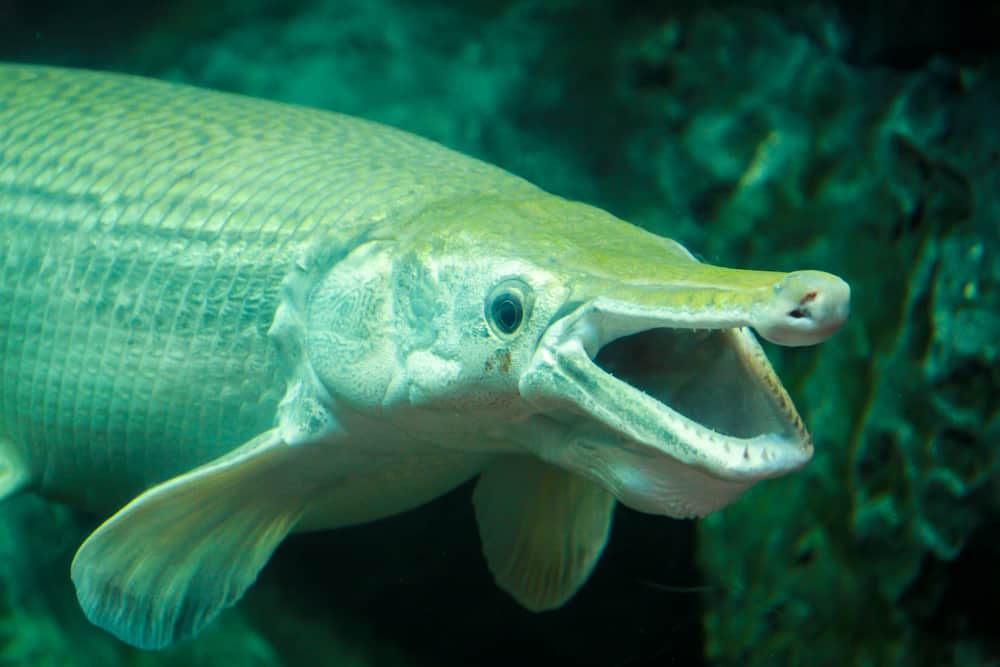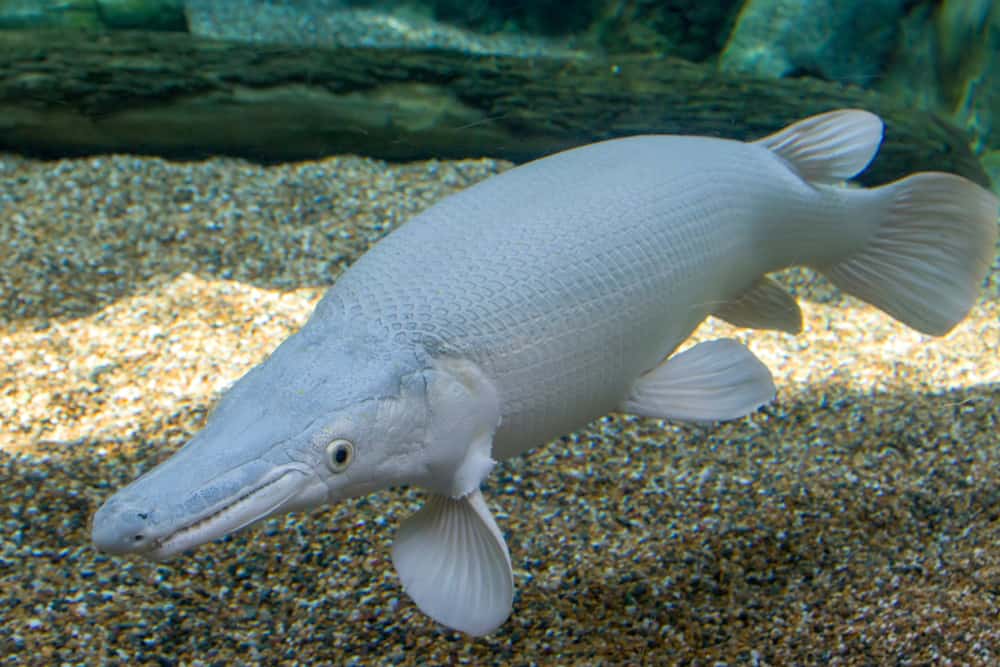The alligator gar has nothing to do with alligators, but with its broad, crocodile-like head and razor-sharp teeth, it’s easy to see how they earned their name.
Adult alligator gars feed on blue crabs, tiny turtles, ducks or other birds, and small animals in addition to fish. Gars are carnivorous, meaning they feed on other creatures. Their food varies depending on the species, where they dwell, and how big they are. Insects, shrimp, tiny crabs, crayfish, and other invertebrates, as well as small fish, are prey for smaller Gars. Larger individuals eat fish, but they also hunt anything that fits in their jaws.
Other species of orange-stained beef fish, such as sunfish, gizzard shades, crepes, bases, catfish, and shiners, feed at night on floating logs or beneath plant cover, including sunfish, gizzard shades, crepes, bases, catfish, and shiners.
After about 10 to 11 days after hatching, the gar begins to feed. Young gars begin by eating copepods and insects, which are tiny crustaceans. They quickly adapt to a diet consisting mostly of fish.
Alligator gar are stalking, ambush predators that prey on ducks and small animals that float on the surface of the water.
They are lonely, solitary fish that appear to be slow yet are fierce ambush hunters. They are opportunistic nocturnal predators and predominantly piscivores, although they also ambush and consume water birds, turtles, and small animals that float on the surface. Their ambush strategy is to float a few feet beneath the surface and wait for unsuspecting victims to swim close enough to reach them. They leap forward and grasp their victim in a sweeping manner, impaling it between their two rows of strong teeth.
They eat sport fish on occasion, although the bulk of stomach content studies indicate they eat forage fish like gizzard shad, as well as invertebrates and waterfowl. Alligator gar populations in brackish water, on the other hand, are known to eat a lot of blue crabs as well as fish like the hardhead catfish. In addition to fishing tackle and boat engine components, diet tests have indicated that they have fishing tackle and boat engine parts in their stomachs.
Facts on Gar Habitat and Lifestyle
- The species’ prehistoric relatives first appeared 157 million years ago and lived in numerous regions of the globe. In the past, alligator gars were found throughout the Mississippi River Valley, maybe as far north as Iowa and as far west as Kansas and Nebraska. Gars now exclusively exist in North and Central America.
- Alligator gars are only known to reside in the lower Mississippi River Valley, which stretches from Oklahoma to the west, Arkansas to the north, Texas and parts of Mexico to the south, and Florida to the east.
- Gars can survive in brackish and even saltwater but prefer the slow-moving pools and backwaters of large rivers, swamps, bayous, and lakes.
- The gar’s blood is aerated by the fish’s large, spongy, and highly vascular air bladder, which acts as a lung. It also permits the fish to ‘breathe’ in low-oxygen environments by allowing them to suck air. It may be able to get up to 70% of the oxygen it requires from the environment.
- Despite their intimidating appearance, gars do not represent a threat to humans and have never been seen to attack them.
- Gar’s eggs are poisonous – It’s a defense strategy against other predators.
- Although alligators have been known to attack them, and juvenile fish are preyed upon by other species, alligator gars have few natural predators.
- The prolonged photoperiod and rising water temperatures start the spawning process in the spring, but flooding is also required to kick off the cycle. When rivers rise and spread across the floodplain, they form oxbow lakes and sloughs, inundating terrestrial plants and providing protection and nutrient-rich habitat for larval fish and fry. Gar go into the grassy, weed-laden shallows to spawn after the water temperature reaches 68 to 82 °F (20 to 28 °C) and all other conditions are satisfied.
- Males compete for the right to reproduce throughout the breeding season. To fight and breed, they assemble in great numbers.
- The female lays her eggs when spawning and then allows numerous men to fertilize them. She may lay hundreds of eggs in a single season, but only a small percentage of them survive to adulthood.
- The eggs take around one week to hatch. Neither the male nor the female is responsible for the protection of the eggs or the young. At around one year of age, the children acquire sexual maturity.
- When they initially appear, larval spotted gars are around 2.5 cm long and hatch from eggs. They have a thin tail with a vibrating thread-like extension that helps them swim when they are young. By the age of two, they are completely formed. Males and females develop at different speeds.
- The majority of the five species are kept in tanks at zoos and aquariums.
- They swim gently, allowing tourists to get a close look at them. Similar species, as well as other huge fish, are housed with them by zookeepers and aquarists.
- None of the gar species are suitable as pets. While some people maintain particular species in their home aquariums, they all grow to be two or three feet long as adults. This makes keeping them as pets challenging because bigger tanks are required.
- The majority of species are not territorial, and they concentrate in places where food is generally available.
- Gars don’t take care of their offspring once hatched.
- Gar are nocturnal fish. Throughout the day, this species will often remain calm among fallen trees or bushes. They come out at night to hunt for prey.
- They occasionally rise to the top of the water to fill their unique swim bladder with air. This specialized bladder functions as a primitive lung, allowing them to survive in low-oxygen environments.
- Even though experts have no verifiable measurements, many people claim to have seen sightings of far bigger dimensions. Some even claim that these fish may grow to be 10 feet long or longer! As a result, they are one of the biggest freshwater fish species in North America.
- The scales of this fish were once utilized as arrowheads by Native Americans.
- Gar are edible, unlike their poisonous eggs.
- Except at the margins of their territory, where numbers have declined owing to habitat degradation, spotted gars are not typically regarded as in need of special conservation measures.
- Spotted gar is listed as a Species of Special Concern in Michigan, threatened in Canada, and recognized as endangered in Arkansas and Kentucky.
- In the wild, gars can live to reach 50 years old.
- In Mississippi’s Lake Chotard, a commercial fisherman captured the world’s largest alligator gar by mistake in 2011. The 8.5-foot-long gar weighed 327 pounds and was estimated to be 94 years old.
- Gar scales were used to produce arrowheads, jewelry, and tools. Its skin was utilized as a robust leather for a variety of uses.
- Gar oils were employed to repel insects.
- Dams along the Mississippi River have removed much of the floodplain habitat that Gar and its offspring require for spawning and growth.
- Gar was also overfished due to a misunderstanding that their toothy look and enormous size meant they ate a lot of the other fish humans loved to eat.
- In the early 1950s, there was a concerted campaign to kill them off.
- Gar flesh isn’t flaky like other fish, and it doesn’t have a fishy flavor.
- It has a chicken-like texture but tastes more like alligator meat than chicken.
- They have a swim bladder that has been modified to allow them to get oxygen from both water and air. The capacity to survive in practically any water condition, along with the highest salt tolerance of any gar species, allows the alligator gar to thrive.
- Alligator gar are exclusively known to live in coastal rivers in Florida’s Panhandle, from Gulf to Escambia counties.
- While most species are brownish or greyish in appearance, the spotted gar, for example, is brown with black dots, which might work as camouflage.
- The weight of a gar is determined by its species. The alligator gar is the biggest, weighing up to 100 pounds (45 kg). The lesser species, such as the Shortnose gar, weighs just 3 lb on average (1.4 kg). The longnose gar, for example, is a medium-sized fish that weighs roughly 50 pounds.
- The lateral line of a garfish is used to detect water movement and pressure changes.
- They have two rows of jagged, sharp teeth. This allows them to retain prey for longer.
- Gar was an excellent local fish for supper before stores had ice and fish markets. Only with the introduction of refrigeration and the contemporary fish market, with species collected thousands of kilometers abroad, did the gar lose its reputation as a favorable dish.
Summary
The Gar is a huge, mostly freshwater fish species. They belong to the Lepisosteiformes family of ray-finned fish, which is an ancient holosteian order. Gars have elongated bodies covered in ganoid scales, and their jaws are equally elongated and loaded with large, pointed teeth.

